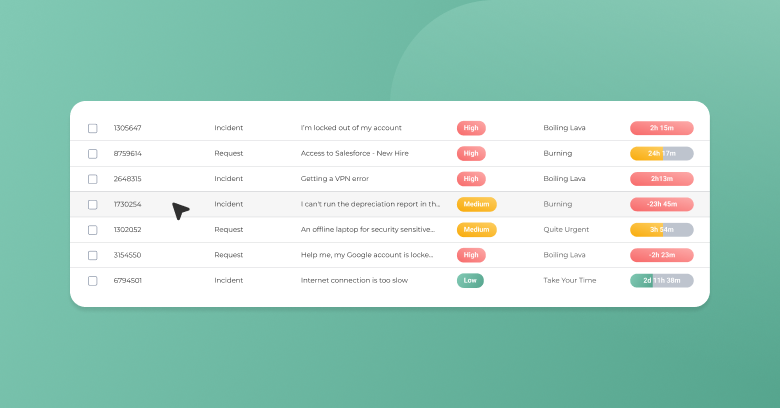Top 4 Keys to Self-Service Portal Success & More

Consider this scenario. After a few months of work, your IT organization has rolled out the new self-service portal. There were a few announcements made in the corporate newsletter, and service desk agents are letting callers know about the new portal during contacts with the service desk.
But the new self-service portal hasn’t had the positive impact that was anticipated. Consumers are not utilizing it as envisioned. In fact, the volume of calls to the service desk have increased, with a number of those calls regarding issues with the self-service portal! And it hasn’t helped that as part of the justification for implementing the self-service portal, two service desk agent positions were eliminated to meet a cost-saving goal. Yikes!
Don’t consumers want self-service? So why aren’t your consumers using the self-service portal? Why isn’t the self-service portal saving your service desk?
Yes, Consumers Want Self-Service
An effective self-service portal is essentially support that never sleeps, available 24/7 and provides a consistent experience for end users. After all, most people prefer to find answers to their questions and issues on their own, on one’s own time. Many would rather not have to make a phone call to the service desk if they don’t have to.
With the increasing pace of technology advancements and the rise of the digital economy, self-service is really the only viable, long-term solution for fulfilling consumer expectations. A recent FastCompany.com article provided some compelling statistics regarding why the future of customer service is self-service:
- 39% of modern consumers expect an email reply within 4 hours (not 24 hours like it used to be)
- 55% of social media users expect an answer in less than 4 hours
- 70% of consumers expect a self-service option for handling commercial questions and complaints
Self-service has become so pervasive in our everyday lives, we no longer notice it. And yet IT professionals are not implementing self-service portals as readily as they ought to. Some agents have had good reasons — perhaps the self-service portal they first tried was buggy, too complex or time-consuming to configure properly. Or internal and external customers were too resistant to change for it to catch on.
Consumers Resist Change (Initially)
If self-service is the long-term solution for meeting consumer expectations, then why are people not always embracing its use? An MIT Sloan Management Review article discussed how people can be intimidated or anxious about new self-service technologies. Companies implement self-service technologies with the expectation that consumers want to happily use them. In reality, consumers are often hesitant to use a new self-service technology if it seems to be a significant departure from how they currently use a service.
When it comes to the service desk, despite all of the challenges associated with a service desk (being placed on hold, getting their issue passed from person to person, etc.), some consumers simply appreciate being able to talk to a live service desk agent when they have an issue or request.
A self-service portal should be implemented with an understanding that the human element is still required – especially at the beginning of a transition. In a Business News Daily interview, Ryan O’Connell, a winemaker at NakedWines.com cautioned that the wrong intentions can hurt a company’s reputation in the long run. “[Some] companies employ self-service tools to cut margins and avoid spending time with their customers,” O’Connell said. “A lot of the time, a good FAQ page or troubleshooting guide accomplishes both of these things.” So, if the reasons for implementing a self-service portal is to cut costs or reduce head-count, then implementation of self-service can fail to perform as anticipated.
Self-Service Success Requires a Strategy, a Plan & the Right Reasons
While there may be some long-term cost savings as a result of implementing a self-service portal, cost savings itself should not be the primary reason for implementing a self-service portal. A 2016 Gartner report suggests that 80% of the organizations that fail to enact a basic plan for their self-service portal implementations will usually incur higher customer service costs.
Success with self-service and self-service portals begins with asking yourself the right questions and defining the business reasons for implementing self-service.
- What are your goals for the self-service portal?
- How will success be measured?
- How will both the IT organization and the company benefit from self-service?
Once the reasons have been identified, develop a realistic strategy.
- Will the self-service portal be rolled out all at once, or phased in?
- Will the portal be made available to any device?
- How should authentication be handled?
- What skills or expertise will be needed for developing the portal and after implementation?
After a strategy has been formulated, then a detailed plan should be developed. Your plan needs to include topics like communication, marketing, training, developing or rewriting knowledge articles rather than focusing on just the implementation of the technology.
4 Keys to Self-Service Success
The Consortium for Service Innovation™, the developers of the Knowledge-Centered Services® (KCS®) methodology, suggest the following four keys for success with self-service:
- Volume & Speed — Provide a sufficient number of articles to be available for consumers in a timely manner. Add enough pertinent content in the knowledge base to support a positive and helpful consumer experience.
- Findability — Articles have to be findable by consumers and content must be written for customers without confusing technical jargon.
- Easy Navigation — The navigation on the self-service portal has to be easy and offer a positive experience. The web offers choices on how to find information and there are no dead ends.
- Marketing & Motivating — Self-service requires an inspiring marketing plan. The “build it and they will come” model doesn’t necessarily work well to get people to consistently use a self-service portal.
Techniques to Get People to Use Your Self-Service Portal
Once you’ve deployed an effective self-service portal and have done all the preliminary work to facilitate success, follow these tips to get everyone motivated to use your self-service portal:
Make a Proper Introduction
Introduce the self-service portal as part of the current live-agent model. The KCS methodology suggests several techniques for making this introduction work well.
First, have a recorded message that discusses the self-service portal for a consumer who is placed on hold. Invite the consumer to co-browse the service desk agent’s desktop as the service desk agent uses the self-service portal to search for a knowledge article. The consumer, in essence, then gets a tour of the portal while having their issue resolved. Lastly, send the consumer the link to the relevant knowledge article from the self-service portal after resolving the consumer’s issue.
Context Is Key
Having the right content in the right context is critical. Simply put, content is only useful if it is actually useful. Consumer-facing content provided by the self-service portal cannot read like an IT technical manual.
Content on the self-service portal must be written in the language of the consumer. In addition, don’t just develop content just in case it’s needed. Monitor consumer issues, trends and also provide content that addresses those issues. Provide content in various formats as well, including video, animation and checklists.
Make It All about the Consumer
Customize and personalize your self-service portal with the consumer experience in mind. For instance, SysAid allows consumers to use a hotkey to automatically include a screenshot or a video capture of an issue they’re experiencing. This lets you better resolve whatever issue was submitted with ease.

Consumers appreciate fast and effective service after all. So, the best self-service portal facilitates frictionless interaction for the consumer.
- Ensure that there are no dead ends in the consumer experience
- Provide consumers with search capabilities
- Create an online community where consumers can post issues as well as share solutions with each other
- Offer the means for consumers to rate the content and their experience with the portal – then make the appropriate adjustments based on that feedback
- Always provide the means to seamlessly engage live support should the consumer request it
Develop Request Models
Develop models for routine requests like password resets or standard software installations. Defining models for routine requests not only ensures consistency with execution but it also enables those requests to be automated.
Your Self-Service Portal Will Be a Win-Win
When you implement a self-service portal conscientiously you will ultimately enhance the user experience as well as elevate the reputation and brand of the IT organization. While choosing the right self-service portal provider is important – properly customizing and swiftly implementing its features will be integral to its overall effectiveness.
In the end, simply follow the preliminary and ongoing steps outlined above and consistently encourage its use despite whatever resistance you may initially encounter. Once your self-service portal transition is finalized and consumers start getting used to it — your work life is going to progressively become a whole lot easier.
Did you find this interesting?Share it with others:
Did you find this interesting? Share it with others:








